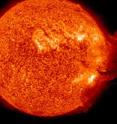NASA sees the sun having a solar blast
2 (medium-sized) solar flare, an S1-class (minor) radiation storm and a spectacular coronal mass ejection (CME) on June 7, 2011 from sunspot complex 1226-1227. The large cloud of particles mushroomed up and fell back down looking as if it covered an area of almost half the solar surface. The Solar Dynamics Observatory (SDO) observed the flare's peak at 1:41a.m. ET (0641 UT). SDO recorded these images (above) in extreme ultraviolet light that show a very large eruption of cool gas. It is somewhat unique because at many places in the eruption there seems to be even cooler material -- at temperatures less than 80,000 K.
When viewed in Solar and Heliospheric Observatory's (SOHO) coronagraphs (right), the event shows bright plasma and high-energy particles roaring from the Sun. This not-squarely Earth-directed CME is moving at 1400 km/s according to NASA models.
The CME should deliver a glancing blow to Earth's magnetic field during the late hours of June 8th or June 9th. High-latitude sky watchers should be alert for auroras when the CME arrives.
Check back shortly as more media is coming in as this is being published.
Source: NASA/Goddard Space Flight Center
Other sources
- Video: NASA releases video of solar flarefrom CBSNews - ScienceThu, 9 Jun 2011, 14:00:27 UTC
- Video: Solar flare caught on camerafrom CBSNews - ScienceWed, 8 Jun 2011, 19:00:20 UTC
- Solar Flare Sparks Biggest Eruption Ever Seen on Sunfrom National GeographicWed, 8 Jun 2011, 18:30:17 UTC
- Sun Unleashes 'Spectacular' & Powerful Eruptionfrom Live ScienceWed, 8 Jun 2011, 17:00:19 UTC
- Sun Unleashes 'Spectacular' Eruptionfrom Live ScienceWed, 8 Jun 2011, 15:30:29 UTC
- Space weather expert downplays threat to Earth from solar flarefrom The Guardian - ScienceWed, 8 Jun 2011, 15:01:08 UTC
- Solar flare eruption puts on cosmic displayfrom CBSNews - ScienceWed, 8 Jun 2011, 12:00:26 UTC
- Solar flare erupts, creating spectacular imagesfrom AP ScienceWed, 8 Jun 2011, 11:00:16 UTC
- Sun unleashes flare, storm and particlesfrom UPIWed, 8 Jun 2011, 3:30:43 UTC
- Sun unleashes flare, storm and particlesfrom UPIWed, 8 Jun 2011, 0:00:36 UTC
- NASA sees the sun having a solar blastfrom Science DailyTue, 7 Jun 2011, 23:30:28 UTC
- NASA sees the sun having a solar blast (w/ video)from PhysorgTue, 7 Jun 2011, 21:30:53 UTC
- Sun Unleashes 'Spectacular' & Powerful Eruptionfrom Space.comTue, 7 Jun 2011, 19:00:31 UTC
- Huge Sun Eruption of June 7, 2011from Space.comTue, 7 Jun 2011, 17:30:27 UTC
